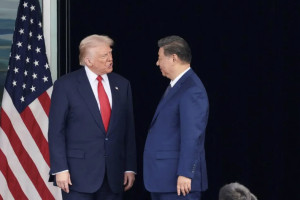The accord, finalised in Busan, South Korea, between U.S. President Donald Trump and Chinese President Xi Jinping, outlines tariff reductions, eased export restrictions, and renewed agricultural trade. The pact, effective for one year, extends a fragile economic truce between the world’s two largest economies.
Tariff Reductions and Fentanyl-Linked Goods
As part of the deal, Washington will halve tariffs on Chinese goods related to fentanyl precursor chemicals—from 20 per cent to 10 per cent. The move lowers the average U.S. tariff rate on Chinese imports from 57 per cent to approximately 47 per cent. This measure aims to balance trade penalties imposed since 2018 while promoting cooperation against the fentanyl crisis that has claimed tens of thousands of American lives.
China Pauses Rare Earth Export Controls
Beijing agreed to suspend for one year the export controls announced earlier this month on rare earth minerals and magnets. The controls had targeted materials essential for defence and technology industries, including gallium, germanium, antimony, and graphite. Under the new framework, China will issue general export licences benefiting U.S. manufacturers. This pause effectively reverses restrictions imposed in 2022 and 2025, easing tensions over critical supply chains.
Mutual Suspension of Retaliatory Tariffs
Both nations agreed to withdraw or suspend retaliatory tariffs and non-tariff measures introduced since March 2025. China will lift duties on U.S. agricultural and food products such as soybeans, pork, wheat, dairy, and cotton. It will also remove several American companies from its unreliable entity list. The U.S., in return, will freeze the expansion of its Commerce Department blacklist of Chinese firms for one year, averting wider disruption in semiconductor and technology exports.
Exam Oriented Facts
- The deal was signed in Busan, South Korea, in November 2025.
- Average U.S. tariffs on Chinese goods reduced from 57% to about 47%.
- China agreed to buy at least 12 million metric tons of U.S. soybeans by end-2025.
- Rare earth export controls by China paused for one year under the accord.
Maritime Fees and Agricultural Commitments
The U.S. agreed to suspend new port fees on Chinese ships for one year, reducing costs for global shippers and stabilising container rates. Beijing, in turn, will remove maritime and logistics sanctions introduced in retaliation. Additionally, China committed to purchasing 25 million metric tons of U.S. soybeans annually from 2026 to 2028 and to resume imports of sorghum and hardwood logs. Both countries will also intensify joint efforts to curb the illicit fentanyl trade by tracking precursor chemical exports and establishing measurable enforcement standards.









